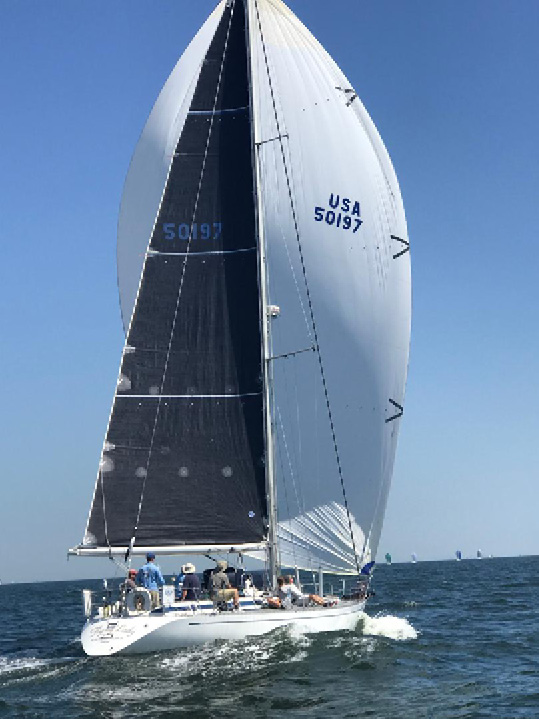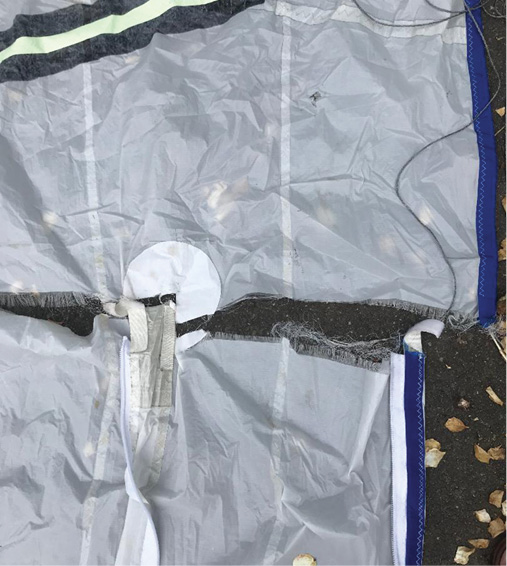By Phil Dickey, MD

Beautiful A2 kite on Flying Lady just after the start of the 2019 Vineyard Race
It seemed like every sailor on the docks at the Royal Bermuda Yacht Club had been on a boat where the A2 kite had blown up during the first day of the 2022 Newport Bermuda Race. Though there are no official tallies of the number of torn sails, Jack Orr, North Sails expert in Bridgeport, CT, said, “Our shop was full of them.” Jack points out that his folks repaired kites from many sail manufacturers, not just North. Why was there so much A2 carnage?
Our beautiful North A2 on the Swan 46 Flying Lady tore not in the blustery 30-knot winds on Sunday, but in 6-8 knots of NW wind on Friday afternoon, after the 20+ knot SW wind that made our start sporty had faded. We faced confused 6-8 foot seas leftover from the sou’wester, and our 32,000 pound boat was struggling in the light nor’wester, with the bow rising up on the waves and slamming down in the troughs.
During one of those downstrokes, our big A2 tore in a spectacular fashion, from about 1/3 up the luff, across the girth to about the halfway point, then down into the foot. We quickly hauled her in and set the A3, also a beautiful sail, but one that on starboard tack forced us to sail about 30 degrees above the rhumb. Thus our quest for silver was essentially over—we needed that A2 to sail down to rhumb, and despite a few painful jibes back to port (which gave us no VMG to Bermuda), we found ourselves 50 miles east of rhumb at the midpoint of the trip. That we managed a middle-of-class finish on Tuesday morning is due to the crew’s resilience and mental toughness.
So why did that sail explode in light winds? Jack Orr reminds me that for most of the St. David Lighthouse fleet, the sails are built for both offshore and inshore sailing. Many of our boats predominantly sail Block Island Race Week or similar events most of the time and sail a Bermuda Race only every other year. The dual-purpose sailing requires compromises in sail design and build, and Jack says that the dual-purpose sails were the ones in his shop for repair.
Heavy boats like Flying Lady generate high shock loads in the luffs of the sails when the bow and tack of the sail accelerate downward while hobby-horsing in big leftover seas in light downwind conditions. Jack reckons that these conditions exist in only about 5% of Bermuda Races—significant periods of light, lumpy, downwind. I have sailed in six Bermuda Races, and this was the first time I have experienced these conditions.
So must we accept that in some races we will lose our kites? One thing Jack says we can do is tighten the luff rope in these conditions, so that the Dyneema, rather than the sailcloth, absorbs the shock loads. (I was previously unaware that the luff ropes could be adjusted.)
Jack also says that conversations with your sailmakers may allow them to design a different kind of spinnaker if your program is more committed to offshore than inshore racing. Nylon fabrics, from which most spinnakers are made, lose strength and get heavy when wet, and they therefore must be treated with water repellants. Racing spinnaker design, in general, has advanced toward using repellants which are coated onto the fabrics. Coating the fabrics make them less porous and more stiff—both are qualities which improve transmission of the energy from wind puffs into boat speed by decreasing wind leakage through the weave and by decreasing energy loss to stretch of the fabric.

Tear beginning on the luff. Note the broken Dyneema luff cord.
These sails are fast in inshore conditions. However, the stiffness tends to make the sail more vulnerable to shock loads and make it less durable, factors that are unfavorable for offshore work. In contrast, cruising spinnakers are generally made from more stretchy fabrics in which the individual fibers are impregnated with water repellant, rather than the entire sail being coated with it. The stretchy cloth is more forgiving in shock loading and is more durable, but it won’t get you silver in Block Island. For programs that are more committed to offshore than inshore racing, the sailmaker can design a “compromise” spinnaker with fabric which can stretch a little more during shock loading, and which can be strengthened along the luff to resist the high instantaneous loads. That’s the direction I’ll be going in 2024.
The bottom line is that your dual-purpose spinnaker will be fine in 95% of our Bermuda Races, at least according to Jack Orr. However, if you want the ideal offshore sail, your sailmaker can build a compromise sail that won’t sink your race in the first afternoon! ■
Phil Dickey is a member of the Essex Yacht Club Regatta Committee.




